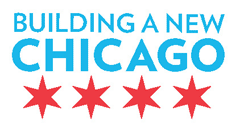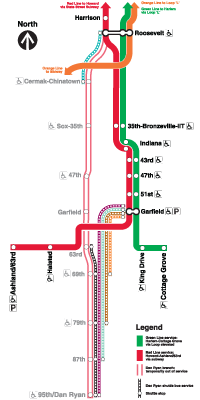Faster. Smoother. Better. Done.
 On May 19, 2013, as part of the Building a New Chicago initiative, CTA launched its Red Line South Reconstruction Project—to completely rebuild the 10.2-mile stretch of tracks from just north of Cermak-Chinatown to 95th Street. The 44-year-old line had exceeded its expected lifespan and was plagued by slow zones and delays.
On May 19, 2013, as part of the Building a New Chicago initiative, CTA launched its Red Line South Reconstruction Project—to completely rebuild the 10.2-mile stretch of tracks from just north of Cermak-Chinatown to 95th Street. The 44-year-old line had exceeded its expected lifespan and was plagued by slow zones and delays.
Five months later, the $425 million project—funded by Governor Pat Quinn’s Illinois Jobs Now! program—delivered a brand new railroad.
On Sunday, October 20, 2013, CTA returned trains to service and unveiled many station improvements, completing the project on time and on budget.
An Important Investment in Public Transit on the South Side
80,000 riders returned to the Red Line will experience a much different commute:
- A daily, round-trip commute that's up to 20 minutes faster for riders who travel between 95th/Dan Ryan and downtown.
- A brand new track bed, including new rail ties, tracks and ballast (the stone material along the tracks).
- Eight cleaned and painted stations with new lighting, improved amenities and artworks.
- New elevators at Garfield, 63rd and 87th stations, making the entire south Red Line accessible to customers with disabilities.
More than Just a New Railroad: New Jobs and Business Opportunities
From community meetings and job fairs to meet-and greets between Disadvantaged Business Enterprises (DBEs) and prime contractors, CTA recognized the need to invest not only in the south Red Line, but in the residents of the affected communities, as well.
The results were tremendous: The Red Line South Reconstruction Project created more than 1,500 jobs including approximately 1,000 construction-related jobs, more than 400-plus bus operators and 100 Traffic Control Aides.
Following months of outreach to the South Side business community, DBEs were heavily involved in the project, with contracts totaling $82.5 million. Of that amount, approximately $56.4 million went to African-American firms.
Video
Construction plan
To complete the work as quickly and effectively as possible, the Red Line completely closed on May 19, 2013, from Cermak-Chinatown through 95th/Dan Ryan. Red Line trains were rerouted south of Roosevelt via the nearby elevated structure Green Line trains use between downtown and Ashland/63rd.
The closure of the Red Line to 95th lasted five months, and impacted the nine Red Line stations from Cermak-Chinatown through 95th/Dan Ryan.
This option was the quickest, most efficient and most cost-effective way to complete this complex project.
Here are some of the benefits of this plan:
- Shortest project duration—5 months vs. 4 years of weekend-only work
- Lowest cost—$75 million in project savings reinvested into local transit improvements to South Red Line stations, including new elevators at Garfield, 63rd and 87th, as well as station improvements to eight stations including painting, lighting repairs and other upgrades. Additionally, the cost savings allowed CTA to provide extensive alternative service throughout the project.
- Quicker trips and more frequent trains, sooner
Service alternatives
During construction, we offered extensive alternate service, providing multiple options for commuters.
- 24-hour Red Line service as far south as 63rd Street via South Side Elevated tracks (normally used only by Green Line services) from Roosevelt through Ashland/63rd.
- Free express shuttle buses with 24-hour, express service from 69th, 79th, 87th and 95th/Dan Ryan stations to the Garfield station on the South Side Elevated (for connections with Green Line and rerouted 24-hour Red Line services to/from Howard, there).
- A local, station-to-station shuttle from 63rd to 95th/Dan Ryan and a fifth shuttle provided express service between the Roosevelt and Cermak-Chinatown stations for local trips not closely served by rerouted Red and Green Line services.
- Free rail entry for shuttle bus riders at Garfield on the Green Line.
- 50-cent-discounted bus rides on many South Side routes.
- Expanded bus service on existing routes.
For some riders, Metra Electric District services were also a good alternative.
Map of shuttle and rerouted 'L' service alternatives

Art
Along with rebuilding the tracks along the south Red Line, we also further enhanced the travel experience with the addition of new public art at the eight stations that received improvements and upgrades as part of the project (all stops from and including Cermak-Chinatown through 87th).
We commissioned and installed new, original works of art that will complement the existing artwork at seven of the stations, while adding the first new public art piece to the Cermak-Chinatown station.
The addition of the new original artwork adds value not only to our stations and the neighborhoods they serve, but it also enhances to the overall transit experience for our riders by promoting a friendly and inviting atmosphere. There are already more than 50 works of art at 41 stations along the Pink, Red, and Brown lines.
To do this, we first held a Call for Artists and four community meetings to discuss the Public Art Project and to solicit input from the communities neighboring these stations in Summer 2013.
On June 23, 2014, Chicago Mayor Rahm Emanuel and CTA unveiled conceptual renderings of proposed art by local artists that'll be installed in Red Line South stations (Cermak-Chinatown–87th; art at 95th is part of a separate project).

See the conceptual renderings (.pdf)
More about why this project was needed
The Red Line is the backbone of the rail system, with nearly 250,000 riders on an average weekday. Opened in 1969, the Dan Ryan Branch tracks and track bed are beyond their expected lifespans. Over the past few decades, rail ties became deteriorated, the ballast didn’t provide sufficient drainage and track conditions required trains to reduce speed in several areas.
This meant longer commutes and less reliability for more than 80,000 commuters on the Dan Ryan Branch each day. 40% of the Dan Ryan Branch required slow zones for safe operation, which meant longer commutes and less reliability for Red Line riders.
Without the improvements made by the Red Line South Reconstruction Project, the percentage of slow zones would have risen in the next year—further increasing commute times and creating more congestion.
Why close this branch of the system for the work to be done?
One of the questions we heard the most was “Why is it best to completely close the South Side Red Line for five, whole months?” We explored other options, including doing the work on weekends, only, but chose the temporary closure due to the following drawbacks:
- Working only on weekends would have taken four years to complete the project and weekend ridership along the Dan Ryan Branch was significant: more than 39,000 riders on Saturdays and more than 29,000 on Sundays
- The five-month construction option saved $75 million over an option to perform work only on weekends
- Continued slow zones for 4 years could have resulted in, average additional commuting time per passenger at a minimum of 20,000 minutes (14 days) which would increase every year, as well as continually increasing potential for delays from developing track issues
- Trains would be more crowded for 4 years
- Fewer community jobs, as a smaller workforce would be required
- Frequent schedule changes, multiple reroutes
Because of they money saved by this approach, we were also able to keep Red Line trains running south of Roosevelt, via the nearby South Side Elevated, as far as 63rd, still serving many riders through the South Side, along with the extensive shuttle buses that made it easy to get there.
Added notes
We also heard people compare this work to previous CTA projects to renovate the Brown Line and parts of the Blue Line in recent years. Those projects were very different in scope to what was done to make commutes faster and more reliable for Red Line South riders.
For example, Brown Line Capacity Expansion work focused on the stations and smaller sections of track, but did not involve a complete reconstruction of the supportive infrastructure down to its foundation, like the Red Line South project. Brown Line work closed some tracks and stations for station construction, but trains could still operate through the area since tracks were still available for use. In the sections where the whole structure was rebuilt, four tracks were available allowing for phased closures that kept at least two tracks open, something simply not feasible with the two-track infrastructure being replaced to 95th.
Similar to how trains on the Brown Line project were rerouted onto other tracks, however, Red Line trains still reached 63rd Street via the Green Line tracks which are just a few blocks away—this meant an easy transfer directly to the Red Line from buses was still available, and was in walking distance in areas served by both lines.
For people who boarded the Red Line south of 63rd, there was a massive shuttle bus operation to bridge the gap and get people to Red Line trains as quickly as possible.
Without question, the five-month reconstruction plan posed challenges to commuters. But this was the best and most-effective way to improve the Red Line—completing the project in the shortest amount of time, at the lowest cost and with the greatest number of alternatives presented by CTA to Red Line South riders.